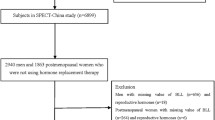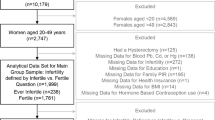Abstract
Cadmium is a widespread environmental pollutant. We aimed to determine whether blood cadmium level (BCL) associates with reproductive hormones in a cross-sectional study. Our data were from SPECT-China. We selected 5690 participants (2286 men and 3404 women), aged 18 years and older, among whom 1589 were postmenopausal women. BCL, blood lead level, total testosterone (TT), estradiol (E2), sex hormone-binding globulin (SHBG), luteinizing hormone, and follicle-stimulating hormone were measured. Results showed that BCL was significantly higher in men (median 1.90μg/L) than that in women (median 1.56μg/L). The median level of cadmium in postmenopausal women was 1.40μg/L. In men, BCL was negatively correlated with TT (Spearmen coefficient = −0.057, P < 0.01) and SHBG (Spearmen coefficient = −0.098, P < 0.01), but in postmenopausal women, this correlation was not observed. In linear regression, after full adjustment for blood lead level, age, body mass index, residence area, economic status, and smoking, TT and SHBG were still negatively associated with BCL in men. Additionally, the association between BCL and TT levels was modified by BMI group (P for interaction = 0.041). However, from base model to fully adjusted model, BCL was not associated with TT and E2 in postmenopausal women. In conclusion, men had higher BCL than women in China, and BCL was associated with TT and SHBG in Chinese men, which may have important implications for male reproductive health. Concerted efforts are warranted to reduce adult cadmium exposure.
Similar content being viewed by others
References
Meeker JD, Rossano MG, Protas B, Padmanahban V, Diamond MP, Puscheck E, Daly D, Paneth N, Wirth JJ (2010) Environmental exposure to metals and male reproductive hormones: circulating testosterone is inversely associated with blood molybdenum. Fertil Steril 93(1):130–140. doi:10.1016/j.fertnstert.2008.09.044
Lewis RC, Meeker JD (2015) Biomarkers of exposure to molybdenum and other metals in relation to testosterone among men from the United States National Health and Nutrition Examination Survey 2011–2012. Fertil Steril 103(1):172–178. doi:10.1016/j.fertnstert.2014.09.020
Borja-Aburto VH, Hertz-Picciotto I, Rojas Lopez M, Farias P, Rios C, Blanco J (1999) Blood lead levels measured prospectively and risk of spontaneous abortion. Am J Epidemiol 150(6):590–597
Sallmen M, Lindbohm ML, Anttila A, Taskinen H, Hemminki K (2000) Time to pregnancy among the wives of men occupationally exposed to lead. Epidemiol (Cambridge, Mass) 11(2):141–147
Tas S, Lauwerys R, Lison D (1996) Occupational hazards for the male reproductive system. Crit Rev Toxicol 26(3):261–307. doi:10.3109/10408449609012525
Jarup L, Akesson A (2009) Current status of cadmium as an environmental health problem. Toxicol Appl Pharmacol 238(3):201–208. doi:10.1016/j.taap.2009.04.020
Park SY, Gomes C, Oh SD, Soh J (2015) Cadmium up-regulates transcription of the steroidogenic acute regulatory protein (StAR) gene through phosphorylated CREB rather than SF-1 in K28 cells. J Toxicol Sci 40(2):151–161. doi:10.2131/jts.40.151
Lacorte LM, Rinaldi JC, Justulin LA, Jr., Delella FK, Moroz A, Felisbino SL (2015) Cadmium exposure inhibits MMP2 and MMP9 activities in the prostate and testis. Biochem Biophys Res Commun 457(4):538–541. doi:10.1016/j.bbrc.2015.01.019
Belani M, Purohit N, Pillai P, Gupta S, Gupta S (2014) Modulation of steroidogenic pathway in rat granulosa cells with subclinical Cd exposure and insulin resistance: an impact on female fertility. BioMed Res Int 2014:460251. doi:10.1155/2014/460251
Ali I, Engstrom A, Vahter M, Skerfving S, Lundh T, Lidfeldt J, Samsioe G, Halldin K, Akesson A (2014) Associations between cadmium exposure and circulating levels of sex hormones in postmenopausal women. Environ Res 134:265–269. doi:10.1016/j.envres.2014.08.009
Interdonato M, Pizzino G, Bitto A, Galfo F, Irrera N, Mecchio A, Pallio G, Ramistella V, Luca FD, Santamaria A, Minutoli L, Marini H, Squadrito F, Altavilla D (2015) Cadmium delays puberty onset and testis growth in adolescents. Clin Endocrinol 83:357–362. doi:10.1111/cen.12704
Wang N, Kuang L, Han B, Li Q, Chen Y, Zhu C, Chen Y, Xia F, Cang Z, Zhu C, Lu M, Meng Y, Guo H, Chen C, Lin D, Lu Y (2015) Follicle-stimulating hormone associates with prediabetes and diabetes in postmenopausal women. Acta Diabetol. doi:10.1007/s00592-015-0769-1
Xu Y, Wang L, He J, Bi Y, Li M, Wang T, Wang L, Jiang Y, Dai M, Lu J, Xu M, Li Y, Hu N, Li J, Mi S, Chen CS, Li G, Mu Y, Zhao J, Kong L, Chen J, Lai S, Wang W, Zhao W, Ning G, 2010 China Noncommunicable Disease Surveillance Group (2013) Prevalence and control of diabetes in Chinese adults. JAMA 310(9):948–959. doi:10.1001/jama.2013.168118
Golden SH, Dobs AS, Vaidya D, Szklo M, Gapstur S, Kopp P, Liu K, Ouyang P (2007) Endogenous sex hormones and glucose tolerance status in postmenopausal women. J Clin Endocrinol Metab 92(4):1289–1295. doi:10.1210/jc.2006-1895
Kalyani RR, Franco M, Dobs AS, Ouyang P, Vaidya D, Bertoni A, Gapstur SM, Golden SH (2009) The association of endogenous sex hormones, adiposity, and insulin resistance with incident diabetes in postmenopausal women. J Clinical Endocrinol Metab 94(11):4127–4135. doi:10.1210/jc.2009-0910
Kim C, Randolph JF, Golden SH, Labrie F, Kong S, Nan B, Barrett-Connor E (2015) Weight loss increases follicle stimulating hormone in overweight postmenopausal women [corrected]. Obesity (Silver Spring, Md) 23(1):228–233. doi:10.1002/oby.20917
Kresovich JK, Argos M, Turyk ME (2015) Associations of lead and cadmium with sex hormones in adult males. Environ Res 142:25–33. doi:10.1016/j.envres.2015.05.026
Lv J, Chen W, Sun D, Li S, Millwood IY, Smith M, Guo Y, Bian Z, Yu C, Zhou H, Tan Y, Chen J, Chen Z, Li L, China Kadoorie Biobank collaborative group (2015) Gender-specific association between tobacco smoking and central obesity among 0.5 million Chinese people: the China Kadoorie Biobank Study. PLoS One 10(4):e0124586. doi:10.1371/journal.pone.0124586
Dhooge W, den Hond E, Koppen G, Bruckers L, Nelen V, van de Mieroop E, Bilau M, Croes K, Baeyens W, Schoeters G, van Larebeke N (2011) Internal exposure to pollutants and sex hormone levels in Flemish male adolescents in a cross-sectional study: associations and dose-response relationships. J Exposure Sci Environ Epidemiol 21(1):106–113. doi:10.1038/jes.2009.63
Steinberger A, Klinefelter G (1993) Sensitivity of Sertoli and Leydig cells to xenobiotics in in vitro models. Reprod toxicol (Elmsford, NY) 7(Suppl 1):23–37
Liu Q, Gu JH, Yuan Y, Liu XZ, Wang YJ, Wang HD, Liu ZP, Wang ZY, Bian JC (2013) Effect of cadmium on rat Leydig cell testosterone production and DNA integrity in vitro. Biomed Environ Sci: BES 26(9):769–773. doi:10.3967/0895-3988.2013.09.009
Niknafs B, Salehnia M, Kamkar M (2015) Induction and determination of apoptotic and necrotic cell death by cadmium chloride in testis tissue of mouse. J Reprod Infertility 16(1):24–29
Arafa MH, Mohammad NS, Atteia HH (2014) Fenugreek seed powder mitigates cadmium-induced testicular damage and hepatotoxicity in male rats. Exp Toxicol Pathol : Official J Ges Toxikologische Pathologie 66(7):293–300. doi:10.1016/j.etp.2014.04.001
Lafuente A (2013) The hypothalamic-pituitary-gonadal axis is target of cadmium toxicity. An update of recent studies and potential therapeutic approaches. Food Chem Toxicol : Int J Published Br Ind Biol Res Assoc 59:395–404. doi:10.1016/j.fct.2013.06.024
Akinloye O, Arowojolu AO, Shittu OB, Anetor JI (2006) Cadmium toxicity: a possible cause of male infertility in Nigeria. Reprod Biol 6(1):17–30
Lafuente A, Marquez N, Perez-Lorenzo M, Pazo D, Esquifino AI (2000) Pubertal and postpubertal cadmium exposure differentially affects the hypothalamic-pituitary-testicular axis function in the rat. Food Chem Toxicol : Int J Published Br Ind Biol Res Assoc 38(10):913–923
Khanna S, Mitra S, Lakhera PC, Khandelwal S (2015) N-acetylcysteine effectively mitigates cadmium-induced oxidative damage and cell death in Leydig cells in vitro. Drug Chem Toxicol 17:1–7. doi:10.3109/01480545.2015.1028068
Koriem KM, Fathi GE, Salem HA, Akram NH, Gamil SA (2013) Protective role of pectin against cadmium-induced testicular toxicity and oxidative stress in rats. Toxicol Mech Methods 23(4):263–272. doi:10.3109/15376516.2012.748857
El-Boshy ME, Risha EF, Abdelhamid FM, Mubarak MS, Hadda TB (2015) Protective effects of selenium against cadmium induced hematological disturbances, immunosuppressive, oxidative stress and hepatorenal damage in rats. J Trace Elem Med Biol : Organ Soc Miner Trace Elem (GMS) 29:104–110. doi:10.1016/j.jtemb.2014.05.009
Li R, Luo X, Li L, Peng Q, Yang Y, Zhao L, Ma M, Hou Z (2015) The protective effects of melatonin against oxidative stress and inflammation induced by acute cadmium exposure in mice testis. Biol Trace Elem Res. doi:10.1007/s12011-015-0449-6
Valko M, Morris H, Cronin MT (2005) Metals, toxicity and oxidative stress. Curr Med Chem 12(10):1161–1208
Telisman S, Cvitkovic P, Jurasovic J, Pizent A, Gavella M, Rocic B (2000) Semen quality and reproductive endocrine function in relation to biomarkers of lead, cadmium, zinc, and copper in men. Environ Health Perspect 108(1):45–53
Yang YH, Zhao MJ, Zhou SJ, Lu WH, Liang XW, Xiong CL, Wan CC, Shang XJ, Gu YQ (2015) Is serum sex hormone-binding globulin a dominant risk factor for metabolic syndrome? Asian J Androl. doi:10.4103/1008-682x.150845
Chubb SA, Hyde Z, Almeida OP, Flicker L, Norman PE, Jamrozik K, Hankey GJ, Yeap BB (2008) Lower sex hormone-binding globulin is more strongly associated with metabolic syndrome than lower total testosterone in older men: the Health in Men Study. Eur J Endocrinol/Eur Fed Endocrine Societies 158(6):785–792. doi:10.1530/eje-07-0893
Lin YS, Rathod D, Ho WC, Caffrey JJ (2009) Cadmium exposure is associated with elevated blood C-reactive protein and fibrinogen in the U. S. population: The third national health and nutrition examination survey (NHANES III, 1988–1994). Ann Epidemiol 19(8):592–596. doi:10.1016/j.annepidem.2009.02.005
Colacino JA, Arthur AE, Ferguson KK, Rozek LS (2014) Dietary antioxidant and anti-inflammatory intake modifies the effect of cadmium exposure on markers of systemic inflammation and oxidative stress. Environ Res 131:6–12. doi:10.1016/j.envres.2014.02.003
Simo R, Barbosa-Desongles A, Lecube A, Hernandez C, Selva DM (2012) Potential role of tumor necrosis factor-alpha in downregulating sex hormone-binding globulin. Diabetes 61(2):372–382. doi:10.2337/db11-0727
Meeker JD, Ferguson KK (2014) Urinary phthalate metabolites are associated with decreased serum testosterone in men, women, and children from NHANES 2011–2012. J Clin Endocrinol Metab 99(11):4346–4352. doi:10.1210/jc.2014-2555
Goncharov A, Rej R, Negoita S, Schymura M, Santiago-Rivera A, Morse G, Carpenter DO (2009) Lower serum testosterone associated with elevated polychlorinated biphenyl concentrations in Native American men. Environ Health Perspect 117(9):1454–1460. doi:10.1289/ehp.0800134
Acknowledgments
This study was supported by the National Natural Science Foundation of China (81270885, 81070677), Clinical Potential Subject Construction of Shanghai Jiaotong University School of Medicine (2014), Ministry of Science and Technology in China (2012CB524906), Science and Technology Commission of Shanghai Municipality (14495810700), and fund for outstanding academic leaders in Shanghai (12XD1403100).
The authors thank Weiping Tu, Bin Li, and Ling Hu for helping organize this investigation.
The authors also thank all the team members and participants from Shanghai, Zhejiang, and Jiangxi Province in the SPECT-China study.
Author information
Authors and Affiliations
Corresponding author
Ethics declarations
The study protocol was approved by the Ethics Committee of Shanghai Ninth People’s Hospital affiliated to Shanghai Jiaotong University School of Medicine. All participants provided written informed consent before data collection.
Conflict of Interest
The authors declare that they have no competing interests.
Additional information
Chi Chen and Ningjian Wang have contributed equally to this work.
Rights and permissions
About this article
Cite this article
Chen, C., Wang, N., Nie, X. et al. Blood Cadmium Level Associates with Lower Testosterone and Sex Hormone-Binding Globulin in Chinese men: from SPECT-China Study, 2014. Biol Trace Elem Res 171, 71–78 (2016). https://doi.org/10.1007/s12011-015-0526-x
Received:
Accepted:
Published:
Issue Date:
DOI: https://doi.org/10.1007/s12011-015-0526-x




